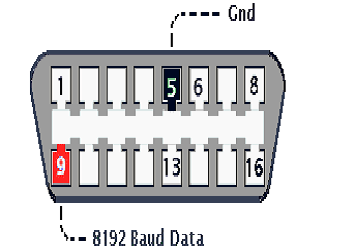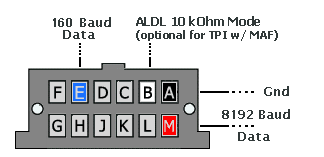
We use the number one and two throughout this article. It’s just meant to help keep things easier to understand. Technically, the first generation system is just called OBD (On Board Diagnostics).
The second generation system released in 1996 is identified as OBD II. What’s the difference between OBD2 and OBD1? The communication speed known as the baud rate is much faster on the newer system.
Also with OBD1 each car maker used their own codes and definitions for identifying failures in the computerized engine management system. This made it difficult for auto mechanics servicing multiple vehicle brands.
OBD2 generic or common code definitions were developed to identify all basic emissions related failures regardless of make, model, foreign or domestic.
This standardization simplified diagnosis and the tools that interface with the control module. Sidebar: You’ll see a scan tool from both Innova and Actron on this page.
These inexpensive car scanners work on some OBD one and all OBD II cars. However, you have to check the application chart to make sure your cars are on the coverage list before purchasing.
Understanding Set Trouble Codes
OBD 2 trouble codes consist of one alpha character followed by a four digit description.
The alpha character indicates the area of the vehicle the failure occurred in. As an example, the letter B is for body, C for chassis, P stands for power-train.
The letter U, which you don’t see as often, stands for network. They consider the network as a manufacturer specific code used only on a specific model or brand.
The body contains the airbag system codes including all discriminating crash sensors, clock spring and the air bag deployment module. The chassis includes the automatic traction control and ABS codes. You’ll find suspension codes also if the vehicle is equipped with active suspension.
The powertrain includes the transmission and engine codes. This is by far the most common system to set computer trouble codes. The first digit of the diagnostic trouble code denotes the origin of the code. Check engine light codes authored by the Society of automotive engineers or, SAE are identified by zero.
Generic OBD2 Codes
These codes are known as generic diagnostic trouble codes since they are the same for every vehicle.
A generic P0301 code stands for cylinder misfire detected on cylinder No 1 regardless if the failure is on an Asian, German or domestic car.
If the first number is a one, this could indicate a manufacturer specific code. These diagnostic trouble codes are part of the manufacturers influenced diagnostic software and vary among car makers.
The second digit in the diagnostic trouble code identifies the system where the malfunction is occurring.
The number 4 is used for the fuel vapor recovery system and the number 3 is used for ignition system as in the example above. The last two digits correspond to specific codes.

OBD1 and OBD2 are similar in that both systems check sensor and actuator circuits for opens, shorts, high resistance in ohms and out of range values returned to the ECM.
However, the failure limits for OBD one are far more forgiving, since a circuit or component must fail completely before the check engine light is illuminated or a diagnostic trouble code is stored. Some would call these the good old days.
In contrast obd2 uses a series of high speed monitors or diagnostic tests that conduct performance evaluations on mostly emission related computer sensors and components. If a monitored circuit fails to meet minimum standards the malfunction indicator lamp is turned on even though the circuit may still be operating.
OBD II Sensors and Subsystems
The power train control module will illuminate the check engine light to notify the driver and store a diagnostic trouble code to aid in the mechanics diagnosis.
This capability makes it possible for emissions related problems to be identified and corrected before excessive pollutants are discharged in the atmosphere via the tailpipe.
This of course only works if the driver heeds the warning light and seeks service. On the big bang theory Penny has been driving around with her service engine soon light on for five seasons.
OBD2 will monitor lots of stuff like misfire detection, fuel control, exhaust gas re-circulation (ERG functions), catalyst efficiency, oxygen sensor data and the heating circuits that warm cold o2 sensors.
Evaporation emissions system (fuel vapor), plus AC refrigerant levels on some models that have climate control also report information back to the control module. OBD II monitors are said to be continuous or non-continuous. As the name indicates continuous monitors run at all times.
These monitors include EGR (exhaust gas re-circulation) components, misfire detection and fuel control. The remaining monitors or noncontinuous, since they do not run until certain criteria has been met.
Enable criteria will include specific driving and engine operating conditions that must occur before the PCM (Power-train control module) will execute or activate the MIL (malfunction indicator light) and store a hard code.
PCM’s can also store pending codes where multiple failures are required before activating the warning light. Consequently, if the vehicle is driven in a way that does not satisfy the enable criteria for a particular non-continuous monitor that monitor will not run and no codes will be set.
This is true even if a real time circuit problem exists. Add this check engine light and car repair website to your favorites or share with a friend. There are some good automobile resources here, so come back and explore.
After you pull your code the quickest way to a successful repair is to follow a diagnostic chart. Take a look at video demonstration I put together using web based service manuals to fix cars at home.
The about us page is also the homepage for this automotive website. This next link takes you to the Start page for Auto-Facts.org.
I have a bunch of pages about check engine light diagnosis. There you can review common problems and learn how to use a scan tool to reset trouble codes.
